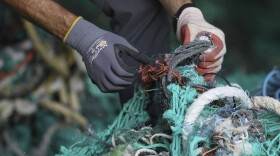Consumers across the country are expected to spend more than $727 billion this holiday season, according to the National Retail Federation. But for tens of thousands of Hawai?i residents without a bank account, shopping means high-interest loans, prepaid cards with fees, and sometimes a continuing cycle of debt.
This is the world of the unbanked.
When N?n?kuli resident and mother of two Shyla Lafaele lost her job a year ago, her bank account took a hit.
"I was unable to keep up with my payments on my credit card, and then it went negative and I couldn’t get out of it," Lafaele said.
The account eventually closed, which only made matters worse for her once she started earning a paycheck again.
"I was unable to open up any kind of bank account. The only route I had was to turn to like a prepaid card…But with that it comes with fees," she said.
Alternative financial services such as prepaid debit cards, cash checking services, and pay day loans, were created for the “unbanked” population, folks like Lafaele.
THE COST OF BEING UNDERBANKED
These services may seem convenient in the short-term for folks without access to mainstream banking services, but they often come with hefty fees, which add up in the long run says Jeff Gilbreath. He?s the director of Lending and Development at Hawaiian Community Assets.
“We are seeing the average cost of what families are spending if they?re underbanked or even unbanked is about $1,200 annually,” Gilbreath said.
In Hawai?i, nearly 20 percent of the population is either unbanked or underbanked, according to a 2017 surveyby the Federal Deposit Insurance Corporation. The unbanked don’t have an account while the underbanked do. But both turn to these expensive alternative financial services to make ends meet.
"It can keep families stuck in this situation where if anything happens, they don?t have any dollars to fall back on," said Gilbreath, "At the same time they can?t move ahead."
THE CYCLE OF POVERTY
Norm Baker, CEO for Aloha United Way, says alternative financial services are a risky move for low-income households.
“[They] are typically a very, very vulnerable to any kind of even minor economic crisis. A child gets sick, requires medicine, car breaks, efrigerator has to be replaced," said Baker, "Things that many can handle. These folks, that little minor economic crisis, can drive them into situations eventually winding up, even being homeless.”
Aloha United Way conducted a study on financial hardship in Hawai?i in 2018 called the ALICE Report. The acronym ALICE stands for Asset-Limited, Income-Constrained, but Employed. The term was coined during the Great Recession to help identify those who were struggling to make ends meet,
“During the recession, 6 percent of the households in Hawai'i fell from this financial self-sufficiency into ALICE,” he said, “Fast forward to 2019. And most of us would probably say that we've recovered from the Great Recession. Everything seems to be going good. The stock markets doing great. Unemployment rates low. This population that fell into ALICE during the recession has never recovered.”
One factor contributing to keeping ALICE households from economic self-sufficiency is this lack of access to mainstream banking services.
For Hilo resident and mother of four Chedel Majamay, getting out of this cycle required hours of financial counseling, an aggressive savings plan, and at times uncomfortable talks with her kids.
"Those would be the “Mommy, can I have this?” You feel like you are the only person out there facing this struggle of living paycheck to paycheck. Feeling like you can?t save money," said Majamay.
Financial education can help unbanked families build knowledge and savings, but building credit or capital outside the mainstream banking system remains a challenge.
SOLUTIONS FOR FINANCIAL INCLUSION
Some organizations in town, including Hawaiian Community Assets, offer microloans with interest rates up to 15 percent. Compare that to pay day loans interest rates which average about 400 percent.
Local financial institution, Bank of Hawai?i, began offering “second-chance” bank accounts in 2015. The Bank of Hawai?i EASE account is tailored to Hawai?i residents like Lafaele, who wouldn?t typically qualify for an account.
But Gilbreath says more options are needed.
“We need to expand this conversation about the unbanked and underbanked to really talk about access to capital and credit for our families,” said Gilbreath, “And if we don’t talk about this, again, you’re gonna see families where one hardship, one emergency happens and they’re gonna be in complete financial ruin.”
We should note that the number of unbanked and underbanked households across the country has been declining in recent years, according to the FDIC. The latest survey found an estimated 32 million Americans do not fully participate in the banking system.




